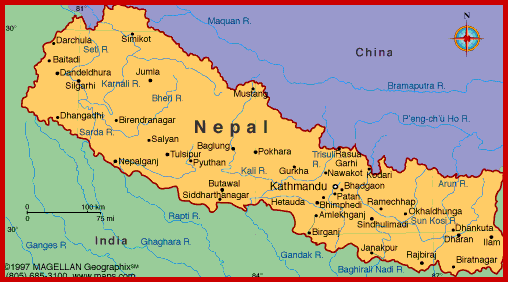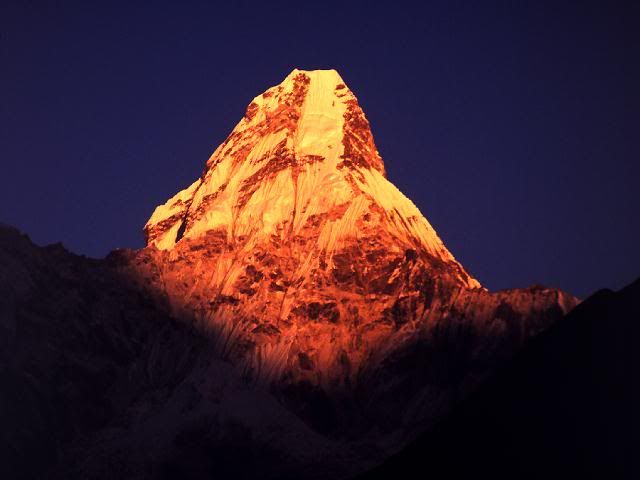
Nepal is a most beautiful country with bio-diversity due to its unique geographical position and altitude variation covering a span of 147,181 sq. kilometers ranging from altitude of 70 meters to 8,848 meters. Mountains, mid hills, valleys and plains dominate the geography of landlocked Nepal that extends from the Himalayan range in the north to the Indo-Genetic lowlands in south. Mt. Everest, the highest point of the Himalayas is in Nepal.
Physical features also include green paddy terraces, wind-swept deserts, dense forests and boggy grasslands. The country is well endowed with permanent rivers, lakes and glacial lakes that originate in the Himalayas. Twenty percent of the land in the country is used for agriculture, where 0.49 percent is used for permanent crops, mainly rice. Climatic conditions of Nepal vary from one place to another in accordance with the geographical features. In the north summers are cool and winters severe, while in south summers are sub tropical and winters mild.
The elevation of the country ranges from 60 meters above sea level to the highest point on earth, Mt. Everest at 8,848 meters, it all within a distance of 150 kilometers resulting in climatic conditions from sub-tropical to arctic. This wild variation promotes an incredible variety of ecosystems, the greatest mountain range on earth, thick tropical jungles teeming with a wealth of wildlife, thundering rivers, forested hills and frozen valleys. Within this impressive geography is also one of the richest cultural landscapes anywhere. The country is a assortment of ethnic groups and sub-groups who speak over 93 languages and dialects. Nepal offers an astonishing diversity of sightseeing attractions and adventure opportunities found nowhere else on earth. And you can join in the numerous annual festivals that are celebrated throughout the year in traditional style highlighting enduring customs and beliefs.
Mainly, Nepali languages is spoken across the country, it is also an official language of Nepal. Nepalese Rupee is the coin that is used across all over the kingdom for exchange. Danfe is the National Bird of this country and Rhododendron is the National Flower: The most exciting titles with which Nepal has been admired and praised by various prominent travel writers in recognition of her cultural richness: They are as known as and well kwon as these following assert. They tell the world about our incomparable & prosperous cultural heritage.
• Living cultural Museum
• Shangri-La
• Roof of the World
• Birth place of the disciple of Peace
• Country of Living Goddess
• City of Golden Pagodas and Parasols
• Himalayan Pilgrimage
• Nature amphitheatre
• Melting pot of Hinduism and Buddhism
• A tiny Kingdom of 103 ethnic groups and 93 spoken languages
• Birth place of Sita
• Abode of Shiva
• Land of Mysticism & Exoticism
• Land of non-stop festivals
Nepal is well known as the country of Mt. Everest all over the world.
Mount Everest Nepali, Sagarmatha is the world's highest mountain, at the altitude of 8,848 meters (29,029 ft) above sea level. It is located in the Mahalangur section of the Himalayas. The international boundary runs across the precise summit point. Its massif includes neighboring peaks Lhotse (8516 m), Nuptse (7855 m) and Changtse (7580 m).The summit of Everest is the point at which the Earth's surface reaches the greatest distance above sea level. Several other mountains are sometimes claimed as alternative "tallest mountains on Earth".
By the same measure of base to summit, Mount McKinley, in Alaska, is also taller than Everest. Despite its height above sea level of only 6,193.6 m (20,320 ft), Mount McKinley sits atop a sloping plain with elevations from 300 m (980 ft) to 900 m (3,000 ft), yielding a height above base in the range of 5,300 to 5,900 m (17,400 to 19,400 ft); a commonly quoted figure is 5,600 m (18,400 ft).[30] By comparison, reasonable base elevations for Everest range from 4,200 m (13,800 ft) on the south side to 5,200 m (17,100 ft) on the Tibetan Plateau, yielding a height above base in the range of 3,650 to 4,650 m (11,980 to 15,260 ft). The summit of Chimborazo in Ecuador is 2,168 m (7,113 ft) farther from the Earth's centre (6,384.4 km (3,967.1 mi)) than that of Everest (6,382.3 km (3,965.8 mi)), because the Earth bulges at the Equator. For this reason Chimborazo is the closest point to outer space.
There were a lot of expenditure climbing in the Mt. Everest but were not succeeds in climbing on this world highest altitude But in 1953, a ninth British expedition, led by John Hunt, returned to Nepal. Hunt selected two climbing pairs to attempt to reach the summit. The first pair (Tom Bourdillon and Charles Evans) came within 100 m (300 feet) of the summit on 26 May 1953, but turned back after running into oxygen problems. As planned, their work in route finding and breaking trail and their caches of extra oxygen were of great aid to the following pair. Two days later, the expedition made its second and final assault on the summit with its second climbing pair, the New Zealander Edmund Hillary and Tenzing Norgay, a Nepali sherpa climber. They reached the summit at 11:30 a.m. local time on 29 May 1953 via the South Col Route. At the time, both acknowledged it as a team effort by the whole expedition, but Tenzing revealed a few years later that Hillary had put his foot on the summit first. They paused at the summit to take photographs and buried a few sweets and a small cross in the snow before descending.


0 comments:
Post a Comment